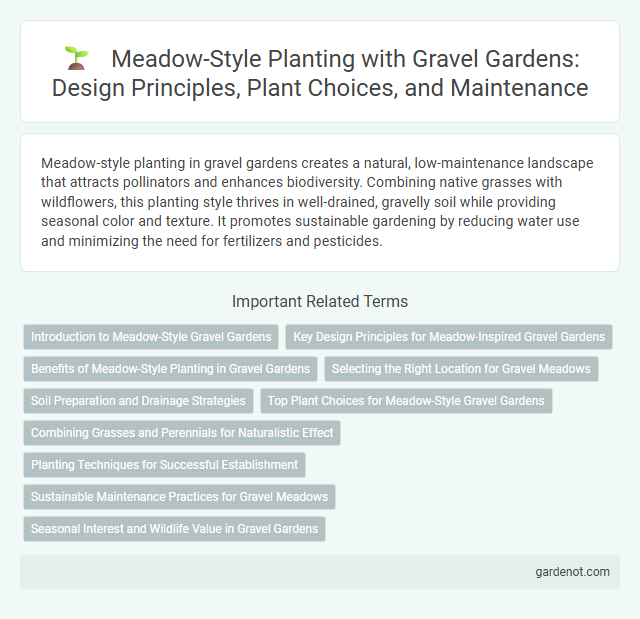Meadow-style planting in gravel gardens creates a natural, low-maintenance landscape that attracts pollinators and enhances biodiversity. Combining native grasses with wildflowers, this planting style thrives in well-drained, gravelly soil while providing seasonal color and texture. It promotes sustainable gardening by reducing water use and minimizing the need for fertilizers and pesticides.
Introduction to Meadow-Style Gravel Gardens
Meadow-style gravel gardens combine drought-tolerant gravel mulch with native wildflowers and grasses to mimic natural meadow ecosystems. This planting approach enhances biodiversity, reduces water usage, and requires minimal maintenance compared to traditional lawns. Key species include ornamental grasses like Festuca and perennials such as Echinacea and Achillea, thriving in well-drained, nutrient-poor gravel substrates.
Key Design Principles for Meadow-Inspired Gravel Gardens
Meadow-style gravel gardens emphasize diverse, native plant selections that thrive in well-drained, nutrient-poor soils, creating sustainable, low-maintenance landscapes. Key design principles include layering perennial grasses with wildflowers to mimic natural meadow ecosystems while ensuring year-round visual interest and seasonal bloom succession. Incorporating irregular, flowing shapes with varied plant heights enhances biodiversity and supports pollinator habitats within the gravel substrate.
Benefits of Meadow-Style Planting in Gravel Gardens
Meadow-style planting in gravel gardens enhances biodiversity by attracting pollinators such as bees and butterflies, supporting a healthier ecosystem. This planting style improves soil health through deep-rooted native grasses and wildflowers, which increase aeration and water retention in gravel substrates. Additionally, meadow plantings require less maintenance and irrigation compared to traditional garden beds, making them a sustainable choice for drought-prone areas.
Selecting the Right Location for Gravel Meadows
Gravel meadows thrive in well-drained, sunny locations where soil remains dry to moderately moist, preventing root rot and ensuring plant health. Choosing a site with full sun exposure promotes the growth of drought-tolerant native grasses and wildflowers ideal for meadow-style planting. Avoiding low-lying, shaded, or overly wet areas is essential to maintain the characteristic airy, open structure of gravel gardens.
Soil Preparation and Drainage Strategies
Meadow-style planting in gravel gardens thrives with well-prepared, nutrient-rich soil that balances moisture retention and drainage. Incorporating organic matter like compost improves soil structure while ensuring adequate aeration prevents waterlogging. Installing subsurface drainage systems or gravel layers beneath plant beds enhances water runoff, promoting healthy root development.
Top Plant Choices for Meadow-Style Gravel Gardens
Top plant choices for meadow-style gravel gardens include native grasses such as Festuca glauca and Deschampsia cespitosa, which provide texture and movement. Perennials like Echinacea purpurea, Achillea millefolium, and Salvia nemorosa offer vibrant color and attract pollinators. Drought-tolerant species such as Sedum and Lavandula thrive in well-drained gravel soils, enhancing the garden's resilience and low-maintenance appeal.
Combining Grasses and Perennials for Naturalistic Effect
Meadow-style planting in gravel gardens emphasizes combining ornamental grasses such as Festuca glauca and Panicum virgatum with perennial flowers like Echinacea purpurea and Rudbeckia hirta to create a naturalistic effect. The contrast between the fine texture of grasses and the bold colors of perennials enhances biodiversity while requiring minimal maintenance and water. This planting strategy supports pollinators and improves soil health, establishing a resilient and sustainable garden ecosystem.
Planting Techniques for Successful Establishment
Meadow-style planting in gravel gardens thrives through the use of specific planting techniques that ensure successful establishment, such as selecting drought-tolerant perennial species and incorporating well-draining soil mixes to mimic natural meadow conditions. Proper spacing allows for adequate air circulation and reduces competition, while layered planting with grasses and wildflowers creates a resilient ecosystem that stabilizes the gravel substrate. Early-season watering combined with mulching helps seedlings develop strong root systems, ensuring longevity and vibrancy in gravel garden meadows.
Sustainable Maintenance Practices for Gravel Meadows
Meadow-style gravel gardens rely on sustainable maintenance practices such as seasonal mowing and controlled watering to promote native biodiversity and reduce resource consumption. Incorporating drought-tolerant meadow plants and organic mulch enhances soil health while minimizing the need for synthetic fertilizers and pesticides. These eco-friendly strategies support long-term resilience and reduce environmental impact in gravel meadow landscapes.
Seasonal Interest and Wildlife Value in Gravel Gardens
Meadow-style planting in gravel gardens enhances seasonal interest by incorporating a diverse mix of native grasses and wildflowers that bloom sequentially from spring through autumn, providing continuous color and texture changes. This planting approach supports wildlife value by offering essential habitats and food sources for pollinators like bees, butterflies, and birds, promoting biodiversity in urban and arid environments. Gravel substrates improve drainage, creating ideal conditions for drought-tolerant meadow species that thrive throughout variable seasonal climates.
Meadow-style planting Infographic

 gardenot.com
gardenot.com